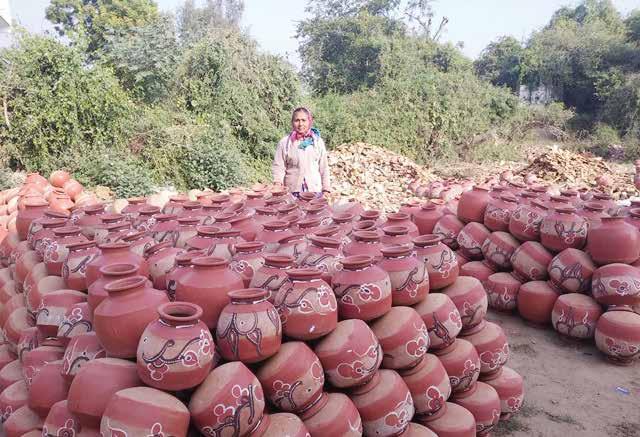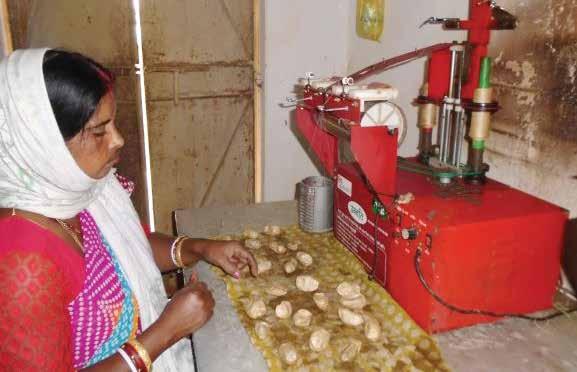33 intricate hand paintings made by the women. Products created by skilled artisans, such as pots, utensils, lamps, cupboards, glasses, lanterns, storage units, religious figurines, and decorative pieces are not only popular for local use but have gained national and international recognition as traditional handicraft of Gujarat. The pottery clusters of the study sites, Gandhinagar and Kutch, are represented in Table 6.
to make it soft and pliable. The kneaded clay is then ‘thrown’ on a potter’s wheel for shaping into desired products. In the studied clusters, the artisans use motorized potter’s wheel, which has increased the productivity manifold. Designs may be drawn on the articles and then they are kept to dry. Dried articles are then ‘tapped’ to even out the shape and smoothen the texture, before putting it in the kiln for firing.
TABLE 6: Cluster details
District
Gandhinagar
Kutch
Village
Units
Rupal
20
Sardhav
20
Randheja
50
Veda
15
Khavda
27
Pottery has received considerable backing from state government agencies, such as Industrial Extension-Cottage (iNDEXT-c), Gujarat Matikam Kalakari and Rural Technology Institute (GMKRTI), handicrafts department, and the Tourism Corporation of Gujarat Limited (TCGL). It is worth mentioning that GMKRTI has been instrumental in developing and incentivizing modern technologies for pottery, to improve productivity, and reduce drudgery.
Production process On average, around 50 pieces of pottery are made per day in each unit of the cluster. If the demand increases, then the potters may make more pieces. The production ceases in the monsoon months, that is, from July to September, as drying of pottery becomes an issue. The work resumes in October or once the rains stop. The mud required for making pottery is sourced from the banks of nearby water bodies and ground. Next, the mud is mixed with water in artificial ponds/enclosures to form clay. In Gandhinagar pottery clusters, the GMKRTI had provided the artisans electric pug mills for kneading the clay
Products
Pots (utensils and flowerpots), pans, glasses, storage units, lamps, decorative pieces, figurines
Energy consumption The modern technologies used in pottery making include electric pug mills, potter’s wheel, and energy-efficient kilns. The GMKRTI has supplied these to selected pottery clusters at subsidized rates. The pug mill is operated for around 20 minutes a day, consuming one and half unit of power and the potter’s wheel is operated for 4–5 hours a day, consuming around half a unit of power. As the power supply is uninterrupted throughout Gujarat, the potters did not face any trouble with operations. However, introduction of the solar PV will reduce their power bills and thereby lower the input cost of operations.
Design of solar PV During the cluster visits, it was seen that enough open spaces (without shade) are available in the vicinity of the pottery-making units for installing ground-mounted systems. In Gandhinagar clusters, households, which were also potterymaking workshops, had sufficient roof area for fixing of rooftop solar systems.






